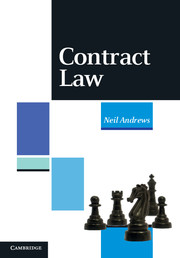Book contents
- Frontmatter
- Contents
- Preface
- Table of cases
- Table of statutes
- Table of statutory instruments
- Part I Introduction
- Part II Formation
- Part III Consideration and intent to create legal relations
- 5 Consideration and estoppel
- 6 Intent to create legal relations
- Part IV Third parties and assignment
- Part V Vitiating elements
- Part VI Terms and interpretation
- Part VII Breakdown and liability
- Part VIII Remedies for breach
- Part IX Illegality and public policy
- Part X The future
- Appendix: A who's who of contract law
- Bibliography
- Index
6 - Intent to create legal relations
from Part III - Consideration and intent to create legal relations
- Frontmatter
- Contents
- Preface
- Table of cases
- Table of statutes
- Table of statutory instruments
- Part I Introduction
- Part II Formation
- Part III Consideration and intent to create legal relations
- 5 Consideration and estoppel
- 6 Intent to create legal relations
- Part IV Third parties and assignment
- Part V Vitiating elements
- Part VI Terms and interpretation
- Part VII Breakdown and liability
- Part VIII Remedies for breach
- Part IX Illegality and public policy
- Part X The future
- Appendix: A who's who of contract law
- Bibliography
- Index
Summary
INTRODUCTION
Summary of main points
(1) The ‘intent to create legal relations’ doctrine is additional to the doctrine of consideration (see chapter 5). Therefore, in the absence of a deed (5.03), if a person wishes to sue on a promise, he must overcome two hurdles: first, he must show that the promise was made in circumstances satisfying the notion of a bargain (the element of ‘consideration’). Secondly, he must show that the promise was made and received in circumstances consistent with an ‘intent to create legal relations’.
(2) In the commercial sphere, there is a strong presumption that such an ‘intent’ goes without saying: there is, in other words, a strong presumption that a commercial agreement is intended to create legal relations, although this can be rebutted explicitly or, perhaps, if the context indicates that the parties did not in fact intend to create legally enforceable rights. In particular, parties to a commercial agreement can explicitly exclude legal relations, notably by use of the formula ‘subject to contract’ (6.06).
(3) But even a commercial arrangement will be presumed to give rise to a contract only if there is a clear commitment, an ‘apparent promise’. A ‘letter of comfort’ (that is, a parent company's vague indication of its current policy to satisfy its subsidiary's debts) does not disclose such a promise; nor will an open-ended and non-committal pattern of dealings between merchants disclose a hard-edged commitment to maintain legal relations.
[…]
- Type
- Chapter
- Information
- Contract Law , pp. 170 - 184Publisher: Cambridge University PressPrint publication year: 2011



